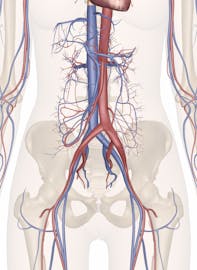Cardiovascular System of the Lower Torso

The cardiovascular system of the lower torso, including the abdomen and pelvis, features many vital blood vessels that supply blood to the many organs of this region. A vast network of blood vessels supplies essential blood to the diverse organs of the digestive, reproductive, urinary, lymphatic and endocrine system in the abdomen and pelvis. Many muscles, nerves, and bones surrounding the vital organs depend on this blood supply as well.
Oxygenated blood from the heart enters the lower torso through the descending aorta, a huge elastic artery that passes anterior to vertebral column. As the descending aorta passes through the diaphragm and enters the abdomen, it becomes known as the abdominal aorta. From the abdominal aorta, many visceral branches separate to perfuse the vital organs of the abdomen, while several parietal branches perfuse the bones, muscles, skin and tissues of the abdominal body wall. The abdominal aorta bifurcates at the pelvis to form the left and right common iliac arteries, which provide blood to the pelvis and hips before continuing into the legs as the femoral arteries.
The visceral branches of the abdominal aorta supply blood to the vital organs of the abdomen. The first visceral branch to separate from the abdominal aorta is the celiac trunk, a major artery that splits into the left gastric, splenic, and common hepatic arteries. Blood from the left gastric artery meets with blood from the right gastric artery to perfuse into the esophagus and stomach. The splenic artery supplies blood to the spleen and further divides into the pancreatic, left gastroepiploic and short gastric arteries to supply blood to the pancreas, stomach and omentum. The common hepatic artery also gives rise to three branches - the proper hepatic, right gastric and gastroduodenal arteries - which supply blood to the liver, gallbladder, stomach and duodenum.
The second visceral branch of the abdominal aorta is the superior mesenteric artery, which splits into the inferior pancreaticoduodenal, jejunal, ileal, ileocolic and the right and middle colic arteries. These arteries spread throughout the abdomen to perfuse the pancreas, small intestine and large intestine with blood.
Inferior to the superior mesenteric arteries are the suprarenal, renal and gonadal arteries. These arteries branch off in pairs from the abdominal aorta to supply blood to the adrenal glands, kidneys and gonads, respectively. In males, the gonadal artery is the testicular artery, which descends through the spermatic cord to supply blood to the testes and epididymis. In females, the ovarian artery supplies blood to the ovaries, Fallopian tubes and uterus.
The most inferior visceral artery is the inferior mesenteric artery, which divides into the left colic artery, sigmoid arteries and superior rectal artery. Each of these branches spreads throughout the abdomen to supply blood flow to the colon and rectum.
Three parietal branches - the inferior phrenic, lumbar, and median sacral arteries - extend from the abdominal aorta to support the tissues of the body wall. The inferior phrenic arteries split from the aorta just inferior to the celiac trunk and deliver blood to the abdominal diaphragm muscle. In the lower back, four pairs of lumbar arteries branch off from the abdominal aorta and carry blood to the first four lumbar vertebrae, spinal cord and the tissues of the lower back. Similar to the lumbar arteries, the median sacral artery carries blood from the abdominal aorta to the sacrum, coccyx and their surrounding tissues.
At the inferior end of the abdomen, the abdominal aorta divides into the left and right common iliac arteries, which pass through the pelvis and carry blood to the thighs. A branch of the common iliac artery, the internal iliac artery, provides blood to the organs and tissues of the pelvis, including the urinary bladder and the reproductive organs of the pelvis.
Deoxygenated blood returning from the tissues of the body collects in the many veins of the lower torso on its way to the heart. Blood from the legs and pelvis passes through the common iliac veins, which unite in the abdomen to form the inferior vena cava. One of the largest veins in the body, the inferior vena cava ascends through the abdomen, picking up blood from the abdominal organs on its way to the heart. Blood from the lower back and pelvis joins the inferior vena cava through the lumbar and gonadal veins. The kidneys and adrenal glands return their blood to the heart via the renal and suprarenal veins, while the diaphragm returns its blood through the inferior phrenic vein.
Deoxygenated blood returning from the digestive organs follows through a special route known as the hepatic portal system. Many smaller veins and venules from the digestive organs merge into the splenic and superior mesenteric veins, which in turn merge to form the hepatic portal vein. The hepatic portal vein carries blood to the liver, where it passes through many tiny sinusoids surrounded by hepatocytes, or liver cells. The passage of blood through the sinusoids allows hepatocytes to store and metabolize the nutrients and chemicals absorbed by the digestive system. After passing through the liver, blood enters the hepatic veins before entering the inferior vena cava and returning to the heart.


